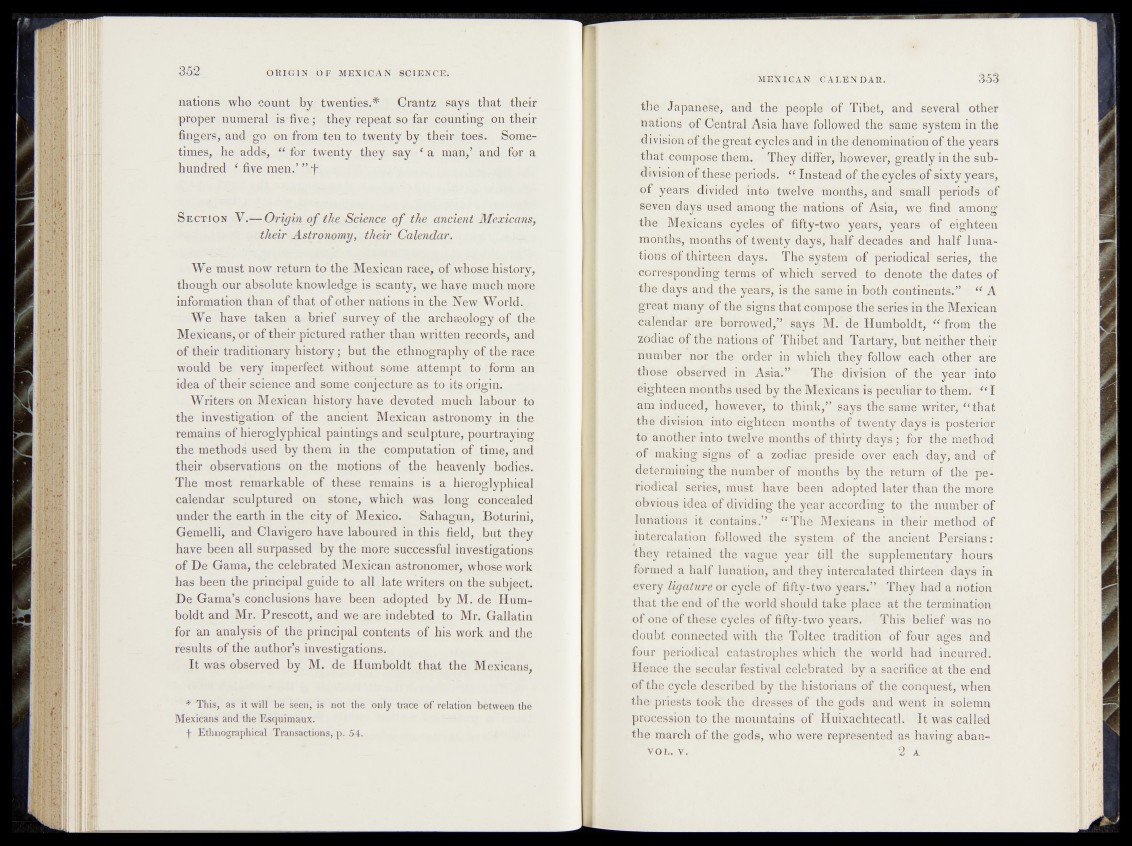
nations who count by twenties.* Cfantz says that their
proper numeral is*five; they repeat so far counting on their
fingers, and go on from ten to twenty by their toes. Sometimes,
he adds, “ for twenty they say c a man,’ and for a
hundred | five men.’ ” f
S ect ion V.— Origin o f the ^Science o f the ancient Mexicans,
their Astronomy, their Calendar.
We must now return to the Mexican race, of whose history,
though our absolute knowledge is scanty, we have much more
information than of that of other nations in the >lfew World.
We have taken a brief survey of the archaeology of the
Mexicans, or of their pictured rather than wri tten records, and
of their traditionary history; but the ethnography ofjtfie race
would be very imperfect without some attempt, to"form ah
idea of their science and some conjecture as to its.prigin.
Writers on Mexican history have devoted much labour to
the investigation of the ancient Mexican astronomy in ^tjb©
remains of hieroglyphical paintings and sculpture, pourtrayjpg
the methods used by them in the computation of time, and.
their observations on the motions of the heavenly bodies.
The most remarkable of these remains is a hieroglyphigal
calendar sculptured on stone, which was long concealed
under the earth in the eity of Mexico. Sahagun, Boturini,
Gemelli, and Clavigero have laboured in this field, .but they
have been all surpassed by the more successful investigations
of De Gama, the celebrated Mexican astronomer, whose work
has been the principal guide to all late writers on the subject.
De Gama’s conclusions have been adopted by M. de Humboldt
and Mr. Prescott, and we are indebted to Mr. Gallatin
for an analysis of the principal contents of his work and the
insults of the author’s investigations.
It was observed by M. de Humboldt that the Mexicans,
* This, as it will t»e keen, is not the only trace of relation between the
Mexicans and the Esquimaux.
-f- Ethnographical Transactions, p. 54.
the Japanese, and the'people' of Tibet, and several other
nations of Central Asia have foll&Wed the same syS.tem in the
division of the greàt'cycîes and in the denomination of the years
that' compose them. They differ, however, greatly in the subdivision
of these-periods. “ Instead'of the eyblesbf sixty years,
b f years divided i n tw e l v e months, and small periods of
seven days used among the nations of Asia, vie. , find among
the Mexicans nÿ’cfës7 of fifty-two" years, years of- eighteen
months, months of twentyTdâysj, half decades1 and half lunations
o f thirteen days?/ '1 The system of periodical series, the
'corresponding terms§j|| which served to ’ denote the dates, of
the days and the years, is the samein both continents.’’ \ tc A
great many of the signs that compose tbd’&eipes in the Mexican
calendar are borrowed,” says M. de Humboldt, ‘“ 'Trom the.
zOdiàç of the nations of Thibet and Tartary, but neither thefl'
number nor/the order'in which they follow each ‘-other are
these' Observed %i Asia/’ The division? Of the* year into
eighteen month# ised by the Mexicans is^sèt^Ö to them. “ I
am induéèdÿ however, to think/n*èays the Same writCr^“ that
the division into eighteen months of twëntÿ dayé’is posterior
to another into twelve months of thirty daÿsj for the method
of making!Signs of a zodiac' pre&idb?over’VeSCh day; and Of
determining the numbëröf months by thè return of the periodical
series, rnust have been adopkddlater than the more
Obvious idea of dividing the yea/hecording to the ntimher of
lunations it contains.” “ The Mexicans^in their method,of
intercalation followed the system of the ancient Persians';'
they retained the vagué year till the‘jSupplementary hours
formed a half lunation, and they intercala tédAhirieén days in
every ligature or cycle'of fifty-two years.” They'had a notion
that the end of the world should take pl’àc#1at the termination
of one of these cycles of fifty-two yéars. This^Mlief was no
doubt connected with the Toltec tradition ofifôur ages and
four periodical catastrophés.which the world had incurred.
Hence the secular festival celebrated by a sacrifice at the end
of the cycle described by the historians of the conquest, when
the priests took the dresses of the gods and went in solemn
procession to. the mountains of Huixachtecatl. It was called
the march of the gods, who were'represented as having aban-
vol. v. 2 A